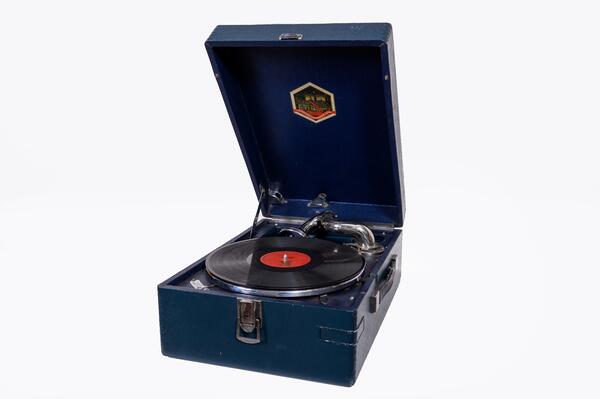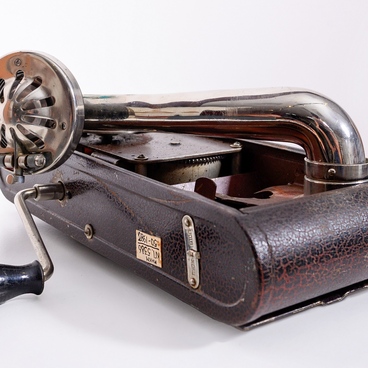A pathephone is a mechanical device for playing gramophone records. It was different from the gramophone because there was no large horn on the outside: a similar device of much smaller size was built right within the pathephone. The pathephone often looked like a briefcase with a handle which made it easy to carry.
The word “pathephone” is based on the name of the French company Pathe, which was the first to supply portable gramophones to the Russian Empire. Then private entrepreneurs began to produce them, but after the revolution, most of the enterprises became the state property. In Soviet times, such devices were produced at several factories in Moscow, Leningrad, Vladimir, Kolomna, and Dnepropetrovsk. The unit from the collection of the National Museum of the Republic of Mari El was manufactured at the Moscow Pathephone Factory of the Moskvoretsky District Industrial Trust.
The pathephone case is closed with a latch. It has a carrying handle on the left side. When the lid was open, it was secured with a support bar, which was located on the right side.
The device is spring-actuated, with one wind-up usually enough to play one side of the record, but less often both. The sound came from the socket, which was placed inside the case. The needle took the recording from the magnetic track, and the diaphragm transmitted the acoustic vibrations to the horn. The needle was set to start recording after the record had spun up to its normal speed of 78 revolutions per minute.
A special stabilizer regulated the speed of the record revolution. It was not recommended to spin the disc by hand, as it would spoil the tracks. It was possible to stop the record with a manual or an automatic brake — this model is equipped with both. The pathephone from the museum’s collection could play gramophone records no more than 300 millimeters in diameter.
The first pathephone models were equipped with disposable steel needles. They lasted for three or four minutes of recording, and then the needle had to be changed. Later they were replaced by the stronger and more durable sapphire ones.
The word “pathephone” is based on the name of the French company Pathe, which was the first to supply portable gramophones to the Russian Empire. Then private entrepreneurs began to produce them, but after the revolution, most of the enterprises became the state property. In Soviet times, such devices were produced at several factories in Moscow, Leningrad, Vladimir, Kolomna, and Dnepropetrovsk. The unit from the collection of the National Museum of the Republic of Mari El was manufactured at the Moscow Pathephone Factory of the Moskvoretsky District Industrial Trust.
The pathephone case is closed with a latch. It has a carrying handle on the left side. When the lid was open, it was secured with a support bar, which was located on the right side.
The device is spring-actuated, with one wind-up usually enough to play one side of the record, but less often both. The sound came from the socket, which was placed inside the case. The needle took the recording from the magnetic track, and the diaphragm transmitted the acoustic vibrations to the horn. The needle was set to start recording after the record had spun up to its normal speed of 78 revolutions per minute.
A special stabilizer regulated the speed of the record revolution. It was not recommended to spin the disc by hand, as it would spoil the tracks. It was possible to stop the record with a manual or an automatic brake — this model is equipped with both. The pathephone from the museum’s collection could play gramophone records no more than 300 millimeters in diameter.
The first pathephone models were equipped with disposable steel needles. They lasted for three or four minutes of recording, and then the needle had to be changed. Later they were replaced by the stronger and more durable sapphire ones.



